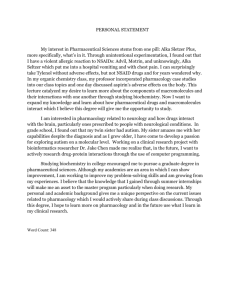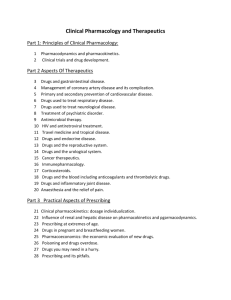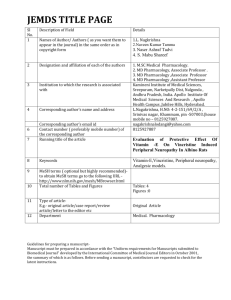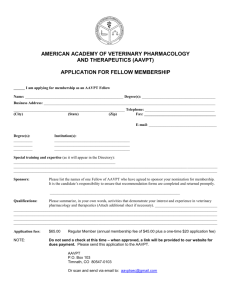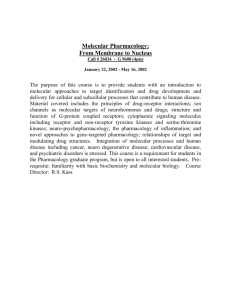Click - Jawaharlal Nehru Technological University
advertisement
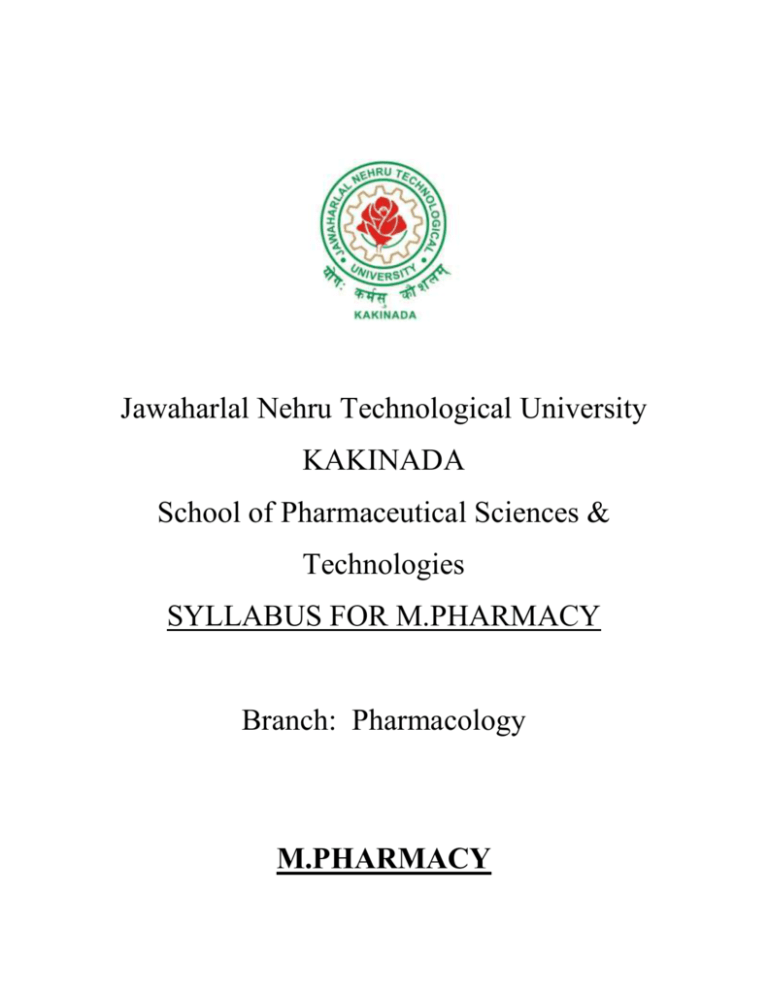
Jawaharlal Nehru Technological University KAKINADA School of Pharmaceutical Sciences & Technologies SYLLABUS FOR M.PHARMACY Branch: Pharmacology M.PHARMACY PHARMACOLOGY I SEMESTER Paper 101 – Modern Analytical Techniques Paper 102 – Pharmacokinetics and Drug Metabolism Paper 103 – Systemic Pharmacology Paper 104 - Pharmacokinetics and Drug Metabolism – Practical Paper 105 – Systemic Pharmacology – Practical Paper 106 – Seminar Paper 107 – Assignments II SEMESTER Paper 201 – Quality Assurance & Drug Regulatory Affairs Paper 202 - Biostatistics Paper 203 – Bioassays & Pharmacological Screening Methods Paper 204 – Selected topics in Pharmacology Paper 205 - Bioassays & Pharmacological Screening Methods - Practical Paper 206 – Seminar Paper 207 – Assignments III SEMESTER & IV SEMESTERS Paper 301 – Seminar – I (On the proposed project work with aims and objectives) Paper 401 – Seminar – II (On the experimentation and results obtained in the Project work) Paper 402 – Thesis evaluation Paper 403 – Defence (Viva – Voce) Paper 404 – Comprehensive Viva Voce M.PHARM SYLLABUS FOR PHARMACOLOGY I SEMESTER Paper 101: Modern Analytical Techniques (Instrumental Methods) (Theory) Principles, instrumentation and applications of the following spectral and magnetic methods of analysis. a. UV- Visible spectrophotometry b. Infrared spectroscopy c. NMR spectroscopy d. Electron Spin Resonance spectroscopy e. Atomic Emission spectroscopy f. Plasma Emission spectroscopy g. X-Ray diffractometry h. Optical Rotatory Diffusion i. Spectrofluorimetry Principles, instrumentation and applications of the following chromatographic techniques. a. GLC b. HPLC c. HPTLC d. Exclusion chromatography e. Super critical fluid chromatography f. Vapor phase chromatography g. Affinity chromatography h. Ion-exchange chromatography TEXT BOOKS 1. Practical Pharmaceutical Chemistry Vol. 1 &II by Beckett & Stenlake. 2. Instrumental Methods of Analysis by Scog and West. 3. Instrumental Methods of Analysis by B.K.Sharma 4. Vogel’s text book of Quantitative Chemical Analysis. 5. Instrumental methods of Analysis by Willard & Merrit. 6. A text book of Pharmaceutical Analysis by K. A. Conners. REFERENCE BOOKS 1. I.P. 2. B.P. 3. U.S.P. 4. Remington’s Pharmaceutical Sciences. 5. Spectroscopy b Silversterin Paper 102 – Pharmacokinetics and Drug Metabolism 1. Drug Absorption: Gastrointestinal, percutaneous and rectal kinetics and factors affecting drug absorption. 2. Drug distribution: plasma protein binding – factors affecting plasma protein binding – Tissue binding – transfer of drugs through biological barriers their therapeutic implication in drug action. 3. Elimination of drugs: Concept of renal clearance and excretion of drugs – biological half-life. 4. Bioavailability of drug products: Bioavailability tests. Reaction of the body to foreign substances: Biotransformation of drugs, phase I and phase II metabolic reactions. 5. Microsomal and non-microsomal biotransformation reactions. Drug metabolism in liver, kidney, intestine and placenta. Drug metabolism in fetus and new born. In-Vitro and In-Vivo studies in drug metabolism; metabolic schemes of selected drugs. 6. Factors influencing drug metabolism: (1) Steriochemical, Physicochemical and biological factors, (2) Physiological: Species difference, strain difference, sex, age, environment factors, (3) Pathological states, (4) Genetic factors – Pharmacogenetics – heritable factors recognized in man by use of drugs. 7. Drug interactions: Pharmacokinetic, Pharmacodynamic drug interactions, Food drug and drink interactions. REFERENCES: 1. Gibaldi, M. and Donald Perrier – Pharmacokinetics Page No. 29/43 2. Rowland, M. and Tozer, T.N. , Clinical Pharmacokinetics – Concepts and applications, Lea and Fibiger, USA 3. Abdou, H.M., Dissolution, Bioavailability and Bioequivalence, Mack Publishing Co. Ltd., Easton, PA 4. Applied Biopharmaceutics and Pharmacokinetics by Leon Shargel, Susanna WU – Pong & Andrew B.C. Yu 5. Principles of Medicinal Chemistry by William O. Foye, Thomas L. Lemke and David A. Williams 6. Wilson and Gisvold’s text book of Organic Medicinal and Pharmaceutical Chemistry by Jaime N. Delgado & William A. Remers REFERENCES: 1. The Pharmacological basis of therapeutics by Joel G. Hardman, Lee E. Limbird and Alfred Goodman Gilman 2. Principles of Medicinal Chemistry by William O. Foye, Tomas L. Lemke & David A. Williams 3. Pharmacology by H.P. Rang, M.M. Dale, J.M. Ritter & P.K. Moore 4. Essentials of Pharmacotherapeutics by F.S.K.Barar 5. Principles of drug action by Golsteins, Aranow and Kalman. Paper 103 – Systemic Pharmacology A detailed study of the mechanism of action, Pharmacology and toxicology of drugs acting on : Central nervous system, Autonomic nervous system, Sensory nerves, Cardio Vascular system, Haemopoietic system, Respiratory system, Digestive system, Excretory system, Reproductive system. A detailed study of the mechanism of action, Pharmacology and toxicology of antinflammatory, antifertility, antidiabetic, antiatherosclerotic, immuno-suppressive drugs, vitamins and chemotherapeutic agents. REFERENCES: Pharmacology by H.P. Rang, M.M. Dale, J.M. Ritter & P.K. Moore Pharmacology and Pharmacotherapeutics by R.S. Satoskar, S.D. Bhandarkar and S.S. Ainapure Pharmacology (Lippincott’s) by Mary J. Mycer, Richard A. Harvey and Pamela C. Champe Essentials of Medical Pharmacology by K.D. Tripathi The Pharmacological basis of therapeutics by Joel G. Hardman, Lee E. Limbird and Alfred Goodman Gilman REFERENCES: 1. Clinical Pharmacy and Therapeutics by Roger Walker and Clive Edwards 2. Clinical Pharmacy by D.R. Laurence, P.N. Bennett and M.J. Brown 3. Clinical Pharmacology by Herphendol Paper 104 - Pharmacokinetics and Drug Metabolism – Practical (Practicals based on theory) Paper 105 – Systemic Pharmacology – Practical (Practicals based on theory) II SEMESTER Paper 201 – Quality Assurance & Drug Regulatory Affairs 1. The concepts of quality assurance, GMP, TQM- Principles and objectives, process control, sources and control of quality variation, statistical quality control, in process quality control, dosage forms control, specifications. 2. GMP- A study of schedule M of Drugs and cosmetics Act, WHO specifications, US FDA guidelines. The study shall include special emphasis on premises, personnel, sanitation, equipment, manufacturing operations and documentation. 3. Validation: Types of validation, protocol for process validation, cleaning validation, validation of air handling, validation of equipment and facilities in sterile and non-sterile areas. Analytical method validation. 4. Ware housing for materials and products; complaints and recalls-evaluation of complaints and recall procedures; finished product release-Quality review-Quality audits – Handling of returned goods, recovered materials and reprocessing. 5. Documentation related to product Development, standard operating procedures, standard test procedures, cleaning methods, quality control documents, batch release document, distribution records, complaints and recalls records, retention of records. 6. Regulatory Affairs – Drugs and Cosmetics Act, DPCO, Intellectual Property Right and Patent laws. 7. New Drug Development and Approval Process: Investigational New Drugs (IND), New Drug Applications (NDA), Supplemental New Drug Application (SNDA). ICH requirements for registration of Pharmaceuticals. TEXT BOOKS 1. The International Pharmacopoeia Vol. 1,2,3,4, 3rd edition General methods of analysis quality specifications for Pharmaceutical substances, Excipients, dosage forms. 2. Quality Assurance of Pharmaceuticals: A compendium of guidelines and related material Vol. 1 and Vol. 2., WHO, (1999). 3. GMP-Mehra 4. Pharmaceutical Process validation by Berry and Nash REFERENCE BOOKS 1. Basic tests for Pharmaceutical substances - WHO (1988) 2. Basic tests for Pharmaceutical substances - WHO (1991) 3. How to practice GMP’s – P.P.Sharma 4. The Drugs and Cosmetic Act 1940- Vijay Malik 5. Q.A Mannual by D.H.Shah 6. SOP Guidelines by D.H.Shah 7. Quality Assurance Guide by OPPI Paper 202 - Biostatistics 1. Tests of significance: Testing hypotheses- principle and applications of Z, t-, F- ratio and chi-square tests in pharmaceutical and medical research. 2. Analyses of Variance: 1-way, 2-way and 3-way classification. 3. Non-parametric tests: sign test, Wilcoxon signed rank test, Wilcoxon sum test, Kruskal Wallis test, run test and median tests. 4. Design of Experiments: Principles of randomization, replication and local control; CRD, RBD, LSD-their applications and analysis of data; Factorial Experiments-Principles and applications; Probit analysis-Dose-effect relationships, calculation of LD50, ED50. 5. Regression and correlation: Method of least squares, Correlation Coefficient, rank correlation and multiple regression. Paper 203 – Bioassays & Pharmacological Screening Methods 1. Principles of Biological standardization: Statistical treatment of modern problems in the biological evaluation of drugs. Methods used in the bio-assay of vitamins, hormones, vaccines, cardiac drugs and other Pharmacopoeial preparations. Test for pyrogens. 2. Bioassay methods for autocoids – development of new bioassay methods. 3. Toxicity tests: Determination of LD50, Acute, sub acute and chronic toxicity studies – Tests for undue toxicity of drugs. 4. Organization of screening for the Pharmacological activity of new substances with emphasis on the evaluation of antihypertensive, cardiac, Psychopharmacological, autonomic, diuretic, Hepatoprotective, antistress and nootropic activities. Cell culture techniques for Pharmacological screening. TEXT BOOKS 1. Microbiological assays by Barton J.Wright. 2. Screening methods by Terner. 3. Text book on Pharmacological Screening methods by Vogel’s. REFERENCE BOOKS I. Pharmacopoeia of India 2. Pharmacopoeial standards for ayurvedic Formulation (Council of Research in Medicine & Homeopathy) 3. Analytical Microbiology by Kavanaagh.F Paper 204 – Selected topics in Pharmacology 1. Neurohumoral transmission in central and autonomic nervous system: Adrenergic, cholinergic, dopaminergic, serotoninergic, histaminic, GABAergic, glutamate and purinergic systems. 2. Autacoid Pharmacology : A Study of the mechanisms involved in the formation, release, pharmacological actions and possible physiological role of histamine, serotonin, kinins, prostaglandins, opioid autacoids, cyclic 3’-5’ AMP, leukotrienes, polypeptides and nitric oxide. 3. Principles of clinical Pharmacology and designs for testing of drugs in humans. 4. Renin – angiotension system its Physiological role Essential Hypertension, Interrelationship between renin angiotension system and sympathetic nervous system – Antagonists of renin – angiotension system. 5. Theories of drug action: Principles of drug action, Ion channels, enzymes. Drug receptor theory: Types of receptors : G-proteins, second messengers and gene therapy. 6. Abnormal actions of drugs such as tolerance, addiction, habituation, idiosyncrasy, allergy, hypersensitivity, adverse drug reactions, antagonism, synergism, potentiation, tachyphylaxis. 7. Principles of drug design, structure activity relationship. Textbooks: 1. Pharmacology by H.P. Rang, M.M. Dale, J.M. Ritter & P.K. Moore 2. Pharmacology and Pharmacotherapeutics by R.S. Satoskar, S.D. Bhandarkar and S.S. Ainapure 3. Pharmacology (Lippincott’s) by Mary J. Mycer, Richard A. Harvey and Pamela C. Champe 4. Essentials of Medical Pharmacology by K.D. Tripathi 5. The Pharmacological basis of therapeutics by Joel G. Hardman, Lee E. Limbird and Alfred Goodman Gilman REFERENCES: 1. Clinical Pharmacy and Therapeutics by Roger Walker and Clive Edwards 2. Clinical Pharmacy by D.R. Laurence, P.N. Bennett and M.J. Brown 3. Clinical Pharmacology by Herphendol Paper 205 - Bioassays & Pharmacological Screening Methods – Practical (Practicals based on theory)

